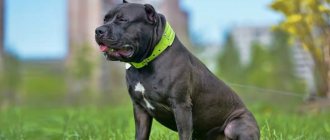Of all the pets, the dog is most often called man's friend. Being close to us, such animals selflessly give their owners love and incredible devotion, serving and protecting. Often, for many owners, a dog is not just a four-legged companion, but also an indispensable assistant.
It often happens that the dog practically becomes a member of the family. But we must not forget that even the calmest, smartest and kindest dogs still remain animals, and besides, they are “armed” with strong and sharp teeth. This means that, hypothetically, a person’s friends can pose a threat to strangers.
To reduce the likelihood of a dog attacking people or animals, our country has rules for walking dogs in public places. These standards must be followed by the owner of any four-legged friend, regardless of the size, age, breed and character traits of the pet.
The peculiarity of the legislation regulating dog walking in the Russian Federation is that there is no single federal law on this topic. The rules for walking dogs and administrative responsibility for violating them are determined by the local laws of each subject of the Russian Federation. Therefore, the main advice for the future owner of an animal is to carefully study the legal regulations in force in the region where he permanently resides. To highlight the basic requirements for dog owners, let’s consider the rules for walking dogs in a public place using the example of laws in force in the Russian capital.
Where to walk your four-legged friend
The answer to this question can be obtained by studying the law “On keeping cats and dogs in the city of Moscow.” The article defining the rules for safe walking of dogs contains specific instructions that walking your pet without being restrained by a muzzle and leash is possible only in officially approved places. We are talking here about special sites, and a similar rule exists in almost all regional laws similar to the one under consideration.
But in real conditions, unfortunately, special areas for dogs are difficult to find even in large cities, not to mention small towns. How can you get out of such a situation?
Of course, you can’t leave an animal without a walk. Therefore, if there is no specially equipped dog park in the locality, then in order to walk your pet and not receive a fine for walking dogs in the wrong place, it is enough to comply with all the other requirements of Article 7 of the above law.
The owner will definitely have to:
- ensure the safety of others by putting a muzzle and leash on the animal;
- not create a threat to the sanitary and hygienic condition of the territory, namely, do not leave “traces of the vital activity” of the pet after a walk;
- control the dog's behavior;
- Avoid places where walking dogs is prohibited by regional legislation.
Places where dogs are not allowed
Despite the relative loyalty to walking dogs outside special areas, the law strictly specifies public places where walking with a four-legged friend is prohibited. These include:
- playgrounds;
- territory of any educational institution;
- territories of medical institutions of any type;
- territories assigned to sports or cultural institutions;
- crowded places.
The latest ban does not apply to city parks.
In addition, according to existing standards, improvised areas for walking dogs should not be less than 30 meters from the entrances of residential buildings. Although even representatives of law enforcement agencies admit that it is simply impossible to do the latter in the city. Therefore, in practice, there may be no complaints against people walking with a pet near a residential building if other hygiene standards and requirements for safe dog walking are observed.
When a leash is necessary
Walking dogs in public places without a leash and collar is prohibited. Situations where even the calmest and most trained dog simply runs alongside are unacceptable from the point of view of legislators and will definitely serve as a reason for administrative punishment of the owner of his four-legged friend. This rule equally applies to owners of both large and very small breeds. Moreover, the walking rules emphasize that the leash should not only help control the pet, but also ensure the safety of the dog itself, for example, when driving along the side of the road.
Requirements for a dog leash
The rules for walking dogs in Moscow, and in many other Russian regions, impose only one requirement on the leash - the length must be sufficient to fully control your pet. What does this mean in practice?
There is, of course, no single standard. The collar and leash are selected taking into account the breed, weight and age of the dog. Experts and experienced dog walkers agree that the so-called short leash, about one and a half meters long, is optimally safe. Complete with a strict collar and muzzle, this gives complete control over the dog's actions. The disadvantage of such a kit is that the dog does not have the opportunity to take a walk, that is, run and warm up. Therefore, as a rule, such control is recommended for fighting pets. Depending on the breed of the dog, the length of the leash can be increased.
And a little more about the ability to control the animal. In some regions, including Moscow and the region, dog walking rules prohibit children and adolescents under the age of 12 (14) from independently leading an animal on a leash, since a child may simply not be able to hold a physically strong and large dog. There is also a ban for persons under the influence of alcohol.
How to use a muzzle correctly
It has already been discussed above how to use a muzzle correctly, but it is worth highlighting points related to the safety of your pet. First of all, make sure that wearing a muzzle does not cause discomfort to the dog.
If the accessory is used to comply with laws and etiquette, it is better to use an open, nylon muzzle in which the dog can open its mouth and breathe with its tongue hanging out. If wearing a muzzle is a temporary measure to prevent the dog from picking up leftover food from the ground, you need to use a closed model, preferably made of plastic.
It is desirable that the fabric or leather muzzle be soft and loose. Metal mesh muzzles are considered the most comfortable, but they can be too heavy. In addition, a dog wearing a metal muzzle, shaking its head, can seriously hit you or others.
Note! In hot weather, it is highly undesirable to use even lightweight models of muzzles.
Why do you need a muzzle?
Sometimes on special forums for dog lovers, disputes arise about how humane the use of a muzzle is and whether a dog can be comfortable wearing it for a walk. The law prescribes the mandatory use of a muzzle for large and/or restless, aggressive animals, dogs of certain breeds and their hybrids. But is it possible to ignore wearing this device when walking dogs that are not prone to aggressive behavior? Professional trainers often warn that it is impossible to anticipate every situation. Even the most non-aggressive and kind dogs can behave unpredictably in a public place towards both people and other animals.
In addition, the muzzle is designed to ensure the safety not only of others, but also of the dog itself. The muzzle primarily prevents the animal from picking up and eating something from the ground. In this way, the owner can protect the pet from accidental poisoning or from the traps of dog hunters.
Walking in the autumn-winter period
Your furry pet is a living creature just like a person. Our pets experience all the same sensations as you and I. Only we can take care of ourselves, and they have no one to rely on except us.
Dogs, just like us, do not like rain, slush, damp and cold weather. Therefore, for such an occasion, you should have several types of clothes for them. For rainy weather - waterproof overalls that will protect the tailed one from dampness and dirt. And for the winter he needs to buy something warmer.
This primarily applies to short-haired quadrupeds, which, obviously, will freeze faster than their furry counterparts. Dog walking rules, of course, do not oblige you to do this. But, if you love your dog and don’t want it to get sick, then I advise you to purchase such equipment, especially since finding it is not a problem - it is sold in any pet store.
Also, do not forget about the general condition of the animal. If your dog is sick or has recently had a vaccination, then the walk should be shortened.
When is it necessary to wear a muzzle?
In what cases do the rules for walking dogs in the city and beyond establish an obligation for the owner to muzzle his pet? Let's look at this issue in more detail. Moscow rules for walking dogs in public places require the mandatory wearing of a muzzle for all four-legged animals without exception that may pose a danger to humans or other animals. This type includes all dogs weighing more than 5 kg.
The capital law also includes a list of four dozen potentially dangerous breeds. Without a muzzle, such animals can only be walked in a fenced dog walking area.
Muzzle requirements
There are no clear requirements for the material or size of the muzzle, as is the case with a leash. In order not to harm the animal and not create situations where the dog can simply chew and remove the muzzle, when choosing a device, it is better to rely on the following tips:
- Buy a muzzle that is safe for your dog - completely breathable and allowing the animal in the muzzle to fully open its mouth.
- Select the product by size. The muzzle should not cut into the animal's nose and not interfere with vision. This condition is a guarantee of the safety of others.
How to walk your dog correctly
A few rules for walking your dog:
- The regime, namely the difference between morning and evening walks. In the morning, the owner does not have many opportunities for a full walk, so the duration can be reduced to 20-30 minutes. In the evening, after work, you should devote more time to your pet - at least 1-1.5 hours in the fresh air.
- The specifics of the walk are influenced not only by the dog’s age, but also by its breed. Thus, small dogs and puppies do not need much time to relieve themselves and run around to their heart's content. But larger animals, such as huskies, need long-term and varied activity every day.
- Walking with the dog is required in special places: there it can walk without a leash, and also socialize with other pets. In the absence of such zones, for walking you need to choose more remote, deserted areas where the animal could feel free and not disturb others.
- The dog is always wearing a collar on the street.
- The owner should take gloves, a dustpan and bags when going outside to clean up after the animal. In most civilized countries, cleaning up your pet's excrement is the norm, and failure to fulfill these duties can result in a fine of a certain amount of money.
- Just in case, it is useful to have a pocket first aid kit with peroxide, iodine, a bandage and drugs that can remove dangerous substances that the dog may eat along the way.
Advice! When crossing public areas on the route or approaching strangers, the dog is fastened to a leash or temporarily held by the collar.
The most sensitive dogs walk in clothes
Walking requirements for owners of small breed dogs
Small breeds include dogs that weigh less than 5 kg. It is assumed that such pets do not pose a threat to humans, although many people, including dog owners, may disagree with this. However, the dog walking rules provide certain concessions for small breeds.
For example, a leash for animals less than 5 kg can be replaced by a special carrier. This point is especially interesting: holding a small dog in your arms, you can visit any public place, even those where animals are not allowed. But at the same time, lowering the pet to the floor and allowing it to roam freely is strictly prohibited.
For public transport, a small animal also has a benefit: the law on dogs allows them to be transported without a muzzle, but with a leash. The same exception applies to walking around the city. A dog that belongs to the small category is completely allowed to be let off a leash if the walk takes place away from any public places. But we should not forget that if the baby caused any damage or attacked a person or animal, the owner will have to answer in the same way as for the actions of a large pet.
Choosing and using a leash
An important aspect of proper and comfortable walking is the choice and use of a leash.
Leashes can be divided into three types:
- Short.
- Free - more than 5 meters long, usually made of tarpaulin.
- Roulette.
Short leashes of a fixed length are more suitable for walking puppies. Depending on your preferences, you can choose a shock-absorbing, braided or tape leash. To control your puppy’s behavior, it is better to give preference to a leash up to 3 meters long.
For walking teenagers of medium and large breeds, as well as for training, it is better to use loose canvas leashes. Yes, in some cases, handling a long leash may be inconvenient for the owner, but until the pet is trained in basic commands, using a tape measure is highly undesirable.
The tape measure has a convenient mechanism - the sagging leash is retracted into the handle, which eliminates the need for the owner to monitor the loops of the tape. This is very convenient, but the tape measure has a disadvantage - the dog is walked on a leash that is constantly taut. If you walk your pet on a roulette from puppyhood, you can be sure that you will not be able to teach the dog to walk next to you and not pull on the leash.
Is it your responsibility to clean up after your dog?
A real wave of outrage is caused by the feces left by dogs. If in many countries cleaning up after your pet is a common thing, our compatriots in most cases ignore this responsibility. We see the result of such a violation every day on the streets and in the courtyards of residential buildings.
The Law on Dogs allows government officials not only to force the owner to clean up after their four-legged friend, but also to draw up a report on an administrative violation followed by a fine. Therefore, the best advice is to purchase accessories such as a special scoop and bags for walking your dog.
Frequency of walking
You need to walk your dog as many times a day as its age requires. So, kids are walked at least 3-4 times a day. The puppy may want to go to the toilet at night, and at this stage of its development, a diaper can be used.
Adult animals are allowed outside about 2 times a day - usually in the morning and evening on weekdays; on weekends, the owner can afford a longer walk or set aside the whole day for walking the dog and spending time together in nature.
An older animal can withstand 8-12 hours between walks, so the specific number of walks may vary depending on the owner’s busy schedule.
Attention! A dog may refuse to go for a walk if it is feeling unwell or in a bad mood.
Owner's responsibility
The Moscow Code of Administrative Violations provides for a number of penalties in the form of fines for dog owners. For example, a fine for walking dogs in the wrong place, walking without a muzzle and a leash, as well as polluting public places, that is, not picking up feces - each of these violations will cost the animal owner from 1 to 2 thousand rubles.
Violation of the rules of transportation by public transport, damage to someone else's (including municipal) property by a dog will cost from 500 to 1000 rubles.
Cases of aggressive dog behavior are punished more severely. If a person’s friend, due to the owner’s carelessness, attacks people or other animals, the fine will be from 4 to 5 thousand. And when the owner himself shows aggression, setting his dog against animals or people, the fine can range from 2 to 5 thousand.
The monetary amounts are indicated for citizens who own dogs. If the violator is an official or legal entity, the amount of the fine increases significantly.
Dog walking law in force
In Russia, walking pets is carried out in compliance with the following standards:
- The safety of people around us is a priority. The safety of any property belonging to individuals or legal entities is also ensured.
- Unregulated movements of the dog on the road, in residential buildings and elevators, in courtyards, areas intended for children's games or sports activities are excluded.
- It is necessary to remove dog litter and waste from public places.
- You cannot walk in areas that are prohibited by local authorities.
- It is forbidden to walk with an aggressive or inappropriate dog (without a muzzle and a leash). By law, if a dangerous animal moves through its owner's territory, a text warning about such a pet must be posted at the entrance.
Note! During the period of official declaration of quarantine and the declaration of an emergency, short walks with the animal near the place of residence are allowed. An example is the situation with coronavirus.
Criminal liability: what will you have to answer for?
A question that often arises in connection with conflict situations between dog owners and opponents of keeping such animals in urban environments: can violation of the rules for walking dogs entail not only administrative, but also criminal liability for a persistent violator? Let's figure out whether it is possible to prosecute the owner of a dog who has bitten a person.
Even if a person regularly violates the rules of dog walking, there will be no criminal prosecution for this. But in a situation where a dog attacked a person, there may also be no criminal liability for the owner of an aggressive animal. A criminal case can be opened only in one case: if the owner deliberately poisoned his dog and in this case serious harm was caused to the victim’s health.











